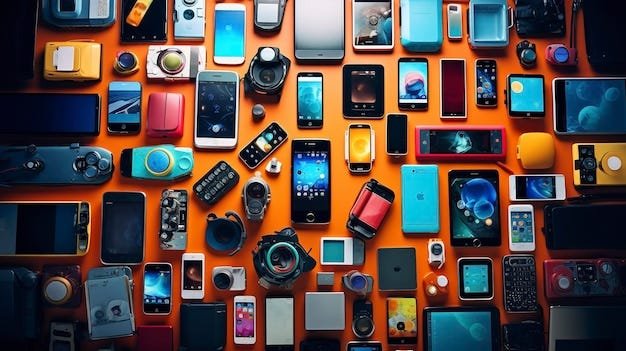The Evolution of Smartphones: What’s Next in Mobile Tech?
Smartphones have come a long way since their inception, transforming from bulky devices with limited features to sleek, pocket-sized powerhouses. Over the years, these gadgets have revolutionized communication, entertainment, and productivity. As we look back at their evolution, it’s exciting to consider what the future holds for mobile technology.
The Journey of Smartphones: A Brief History
1. The Early Days: Birth of the Smartphone (1990s)
The first smartphones were a blend of a traditional mobile phone and a PDA (Personal Digital Assistant). Notable early devices include:
- IBM Simon (1994): Widely considered the first smartphone, it offered email, a calendar, and a touchscreen.
- Nokia 9000 Communicator (1996): A clamshell device with a physical keyboard and basic web access.
These devices were revolutionary but limited by primitive hardware and software capabilities.
2. The Rise of Modern Smartphones (2000s)
The 2000s marked the transition to more user-friendly smartphones.
- BlackBerry Devices: Dominated the early 2000s with email-centric designs popular among business users.
- Apple iPhone (2007): Redefined the smartphone with a sleek design, multi-touch display, and App Store.
- Android OS (2008): Introduced by Google, it fostered competition and innovation, with brands like Samsung and HTC joining the fray.
3. The Smartphone Boom (2010s)
The 2010s saw rapid advancements in design, features, and performance.
- Larger Displays: Screens grew bigger with higher resolutions, introducing trends like edge-to-edge displays.
- Camera Evolution: Dual and triple cameras became standard, pushing boundaries in photography.
- 5G Networks: Laid the foundation for ultra-fast internet speeds and low latency.
Key Innovations Driving the Future of Smartphones
1. Foldable and Rollable Displays
Foldable devices like the Samsung Galaxy Z Fold series and rollable prototypes are pushing the boundaries of screen technology. These gadgets offer larger displays while maintaining portability, redefining multitasking and entertainment.
2. AI-Powered Personalization
Artificial Intelligence (AI) is becoming integral to smartphones:
- AI Cameras: Automatically optimize settings for professional-quality photos.
- Voice Assistants: Smarter and more contextual, improving productivity and accessibility.
3. Extended Reality (XR) Integration
Augmented Reality (AR) and Virtual Reality (VR) are becoming mainstream in gaming, education, and shopping. Apple Vision Pro and ARKit pave the way for more immersive experiences directly from your smartphone.
4. Sustainable Materials and Manufacturing
With growing concerns about e-waste, brands like Fairphone are leading the way with recyclable materials, modular designs, and repairability. Expect more eco-friendly innovations in the coming years.
5. Biometric and Security Advancements
While fingerprint and facial recognition are already standard, the next wave includes:
- Under-display Biometrics: Seamless integration into the screen for enhanced security.
- Behavioral Biometrics: Analyzing user habits like typing patterns for fraud prevention.
6. Satellite Connectivity
Apple and Huawei have introduced satellite communication for emergencies in remote areas. This feature could expand to provide broader coverage in future devices.
What’s Next in Mobile Technology?
1. Holographic Displays
Holograms are no longer confined to sci-fi. Future smartphones may feature 3D holographic projections for video calls, gaming, and presentations. Companies like RED and Leia Inc. are already experimenting with this technology.
2. Longer Battery Life and Faster Charging
Battery technology is poised for a breakthrough:
- Solid-State Batteries: Promising higher energy density and faster charging.
- Wireless Over-the-Air Charging: Devices could charge remotely without cables or docks.
3. Quantum Computing Integration
Quantum processors could bring unparalleled speed and efficiency, enabling smartphones to handle complex tasks like real-time translation and advanced simulations.
4. Advanced Health Monitoring
Smartphones might become critical tools for health diagnostics, incorporating sensors capable of measuring blood glucose, hydration levels, and even early disease detection.
Challenges and Opportunities in Smartphone Evolution
Challenges:
- E-Waste: As technology evolves rapidly, managing discarded devices remains a pressing issue.
- Privacy Concerns: With AI and biometric advancements, ensuring data security is paramount.
- Affordability: Premium features often come with high price tags, limiting accessibility.
Opportunities:
- Global Connectivity: Bridging digital divides in underserved regions through affordable smartphones.
- Customizability: Modular designs could allow users to personalize devices according to their needs.
Conclusion
The evolution of smartphones has been a journey of continuous innovation, changing the way we communicate, work, and play. As foldable designs, AI integration, and XR experiences become the norm, the future of mobile technology looks brighter than ever.
While challenges like sustainability and privacy loom large, they also present opportunities for brands to innovate responsibly. As we move forward, one thing is certain: smartphones will continue to be at the forefront of technological transformation.


